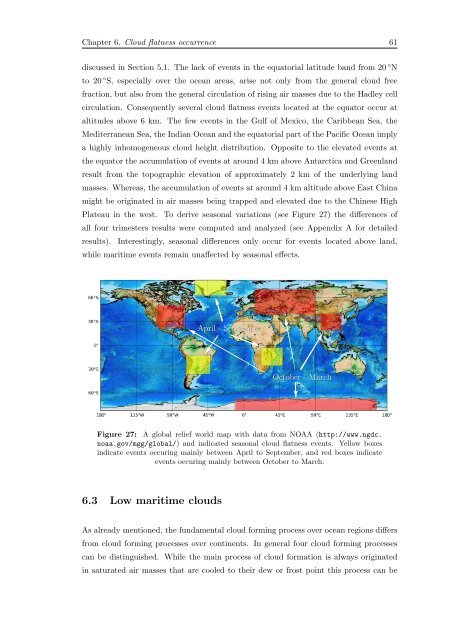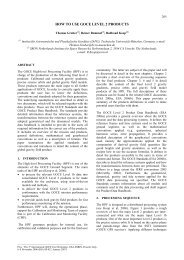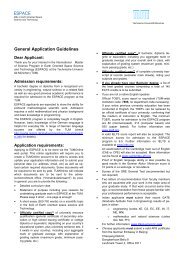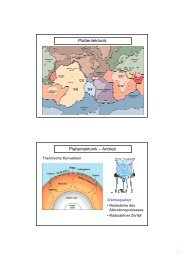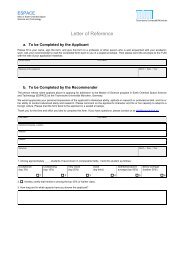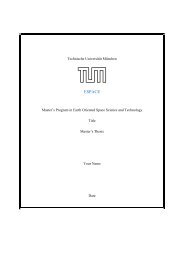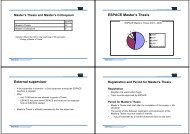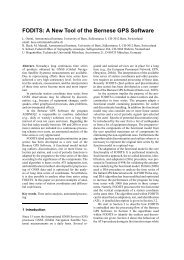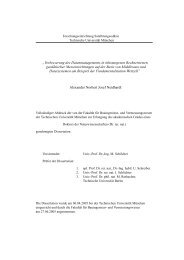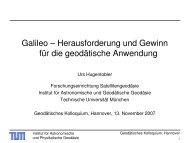Cloud Statistics from Calipso Lidar Data for the ... - espace-tum.de
Cloud Statistics from Calipso Lidar Data for the ... - espace-tum.de
Cloud Statistics from Calipso Lidar Data for the ... - espace-tum.de
You also want an ePaper? Increase the reach of your titles
YUMPU automatically turns print PDFs into web optimized ePapers that Google loves.
Chapter 6. <strong>Cloud</strong> flatness occurrence 61<br />
discussed in Section 5.1. The lack of events in <strong>the</strong> equatorial latitu<strong>de</strong> band <strong>from</strong> 20 ◦ N<br />
to 20 ◦ S, especially over <strong>the</strong> ocean areas, arise not only <strong>from</strong> <strong>the</strong> general cloud free<br />
fraction, but also <strong>from</strong> <strong>the</strong> general circulation of rising air masses due to <strong>the</strong> Hadley cell<br />
circulation. Consequently several cloud flatness events located at <strong>the</strong> equator occur at<br />
altitu<strong>de</strong>s above 6 km. The few events in <strong>the</strong> Gulf of Mexico, <strong>the</strong> Caribbean Sea, <strong>the</strong><br />
Mediterranean Sea, <strong>the</strong> Indian Ocean and <strong>the</strong> equatorial part of <strong>the</strong> Pacific Ocean imply<br />
a highly inhomogeneous cloud height distribution. Opposite to <strong>the</strong> elevated events at<br />
<strong>the</strong> equator <strong>the</strong> accumulation of events at around 4 km above Antarctica and Greenland<br />
result <strong>from</strong> <strong>the</strong> topographic elevation of approximately 2 km of <strong>the</strong> un<strong>de</strong>rlying land<br />
masses. Whereas, <strong>the</strong> accumulation of events at around 4 km altitu<strong>de</strong> above East China<br />
might be originated in air masses being trapped and elevated due to <strong>the</strong> Chinese High<br />
Plateau in <strong>the</strong> west. To <strong>de</strong>rive seasonal variations (see Figure 27) <strong>the</strong> differences of<br />
all four trimesters results were computed and analyzed (see Appendix A <strong>for</strong> <strong>de</strong>tailed<br />
results). Interestingly, seasonal differences only occur <strong>for</strong> events located above land,<br />
while maritime events remain unaffected by seasonal effects.<br />
April-September<br />
October-March<br />
Figure 27: A global relief world map with data <strong>from</strong> NOAA (http://www.ngdc.<br />
noaa.gov/mgg/global/) and indicated seasonal cloud flatness events. Yellow boxes<br />
indicate events occuring mainly between April to September, and red boxes indicate<br />
events occuring mainly between October to March.<br />
6.3 Low maritime clouds<br />
As already mentioned, <strong>the</strong> fundamental cloud <strong>for</strong>ming process over ocean regions differs<br />
<strong>from</strong> cloud <strong>for</strong>ming processes over continents. In general four cloud <strong>for</strong>ming processes<br />
can be distinguished. While <strong>the</strong> main process of cloud <strong>for</strong>mation is always originated<br />
in saturated air masses that are cooled to <strong>the</strong>ir <strong>de</strong>w or frost point this process can be


